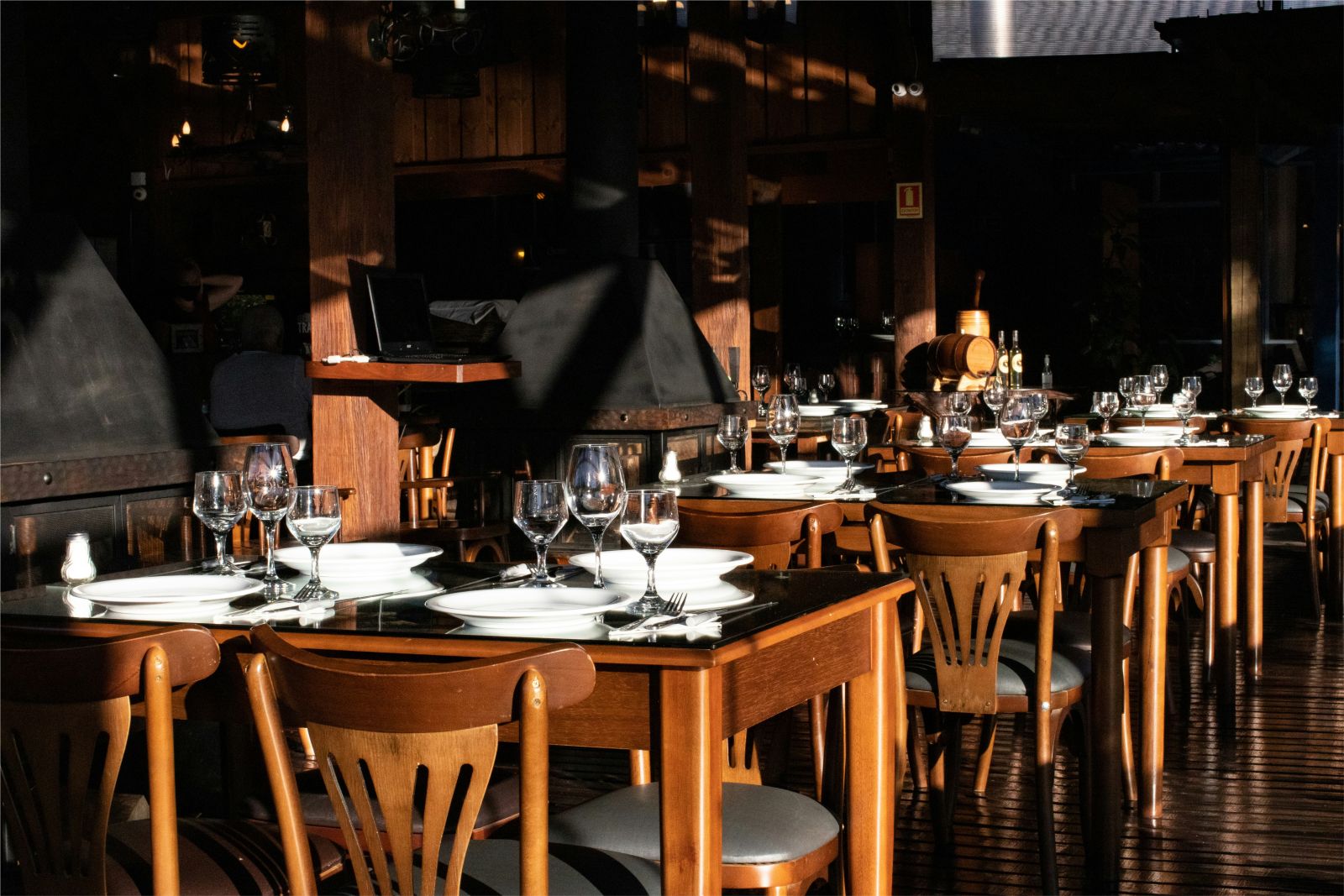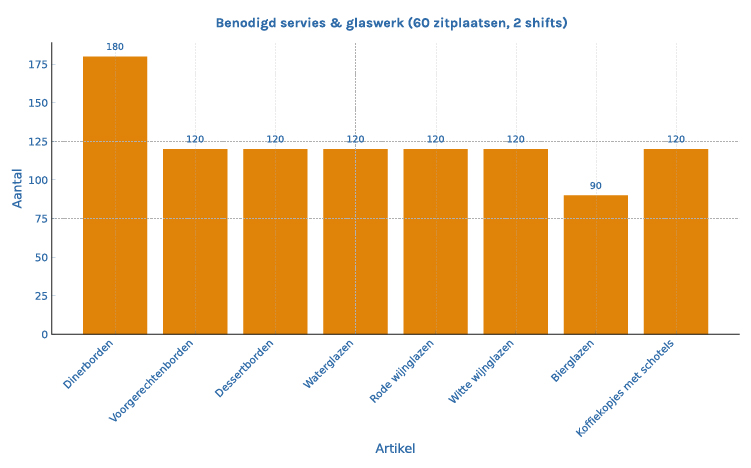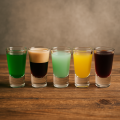How much crockery and glassware does a restaurant need?

The sun is shining, the terraces are full: the ideal situation for a restaurant. Until you find out there are no clean wine glasses left. The washing-up is in progress, but you don't have time to wait for it. As a restaurant owner, it is hugely important to have enough glassware and crockery in the cupboards. Having too few glasses or plates is a situation you never want to find yourself in, causing you to lose turnover. But how do you know what is sufficient crockery and glassware for your restaurant? You can read about it in this blog!
What glassware and tableware do you need in your restaurant?
A thriving restaurant is not just about a strong menu or friendly staff. The right crockery and glassware also plays an important role. It ensures an overview in the kitchen, speed of service and a neat appearance on the table. But what exactly do you need as a restaurant? Below is an overview by main category of the most commonly used items.
Plates
Plates form the basis of every dish. Each type of course requires its own size or shape:
- Dinner plates (21-30 cm) are the most commonly used, especially for main courses.
- Appetiser plates (15-21 cm) are suitable for lighter dishes such as salads or cold starters.
- Dessert plates (15-17 cm)are used for desserts like cake, ice cream or cheese.
- Pastry plates (15-17 cm) are handy for individual coffee occasions or small sweet snacks.
- Bread plates (15-17 cm) are used for appetisers with bread and butter, for example.
Ideally, choose plates from the same tableware line in different sizes. This creates a calm and professional look, both on the table and in the cupboard. Read more about it in the blog on different plates per dish.
Bowls and dishes
For soups, pasta or side dishes, good bowls and dishes are indispensable:
- Soup bowls with wide rims ensure a neat presentation.
- Deep pasta bowls are ideal for hot main dishes with sauce.
- Small bowls are used for side dishes such as chips, vegetables or sauces.
- Salad bowls are available both for individual portions and for sharing.
When buying, pay attention to stackability and size, especially if you have limited storage space.
Glass
Glassware largely determines the presentation of drinks. A suitable glass is available for every drink:
- Water glasses are standard at every table setting.
- Wine glasses - both for white and red wine - vary in shape for optimum taste experience.
- Beer glasses vary by type of beer: from classic lager to speciality beer.
- Champagne flutes or cocktail glasses may be needed if you are also serving festive or mixed drinks.
It's smart to match your choice of glassware to your menu. A wine bar requires more variety than a lunchroom. Read which glass goes with which drink in this blog.
Cups and mugs
Coffee and tea are often the conclusion of a visit, and therefore deserve attention:
- Coffee cups are the basis for a great cup of coffee.
- Espresso cups are small and retain heat well.
- Cappuccino cups have a wider shape and are suitable for milk drinks.
- Tea glasses or ceramic mugs go well with a loose tea menu.
Make sure the crockery is comfortable to hold, firm to the touch and retains heat well. Catering cups often have thicker walls to keep drinks hot for longer.
Why sufficient crockery and glassware is indispensable
As a restaurant, you can have the best employees and serve the tastiest food, but if there is not a clean plate to serve the food on, the whole experience falls apart. Having enough glassware and crockery is not 'convenient', no, it is essential.
Picture this: it is rush hour. The tables are full, new guests are just taking their seats, and then it turns out there are no more water glasses available. The dishes are running, but you have to wait. The result? Guests wait unnecessarily long, service gets frustrated and the atmosphere becomes restless. Something you want to avoid at all times, right?
At the same time, too much glassware and crockery isn't ideal either. It seems convenient to have super much in stock, but it's not always so. The more crockery you have, the more likely it is to break. Besides, having good glassware and crockery is an investment: the more of it you have, the more space and money it costs.
For a long time now, restaurants have not just been about the food. It's about the whole experience. The crockery and glassware that people eat and drink from seems like a small detail, but it contributes to a good restaurant experience.
How do you calculate how much glassware and crockery you need?
When decorating a restaurant, most entrepreneurs quickly think of atmosphere, menu and staff. Logical. But one of the most underestimated success factors is in the details: the right amount of crockery and glassware. Not too little, but not too much either. A well-considered stock prevents stress in the kitchen, increases service efficiency and contributes to the guest experience.
Take, for example, a restaurant with 60 seats. On an average day, two meals are served per seat, so you can count on two table rounds per seat. If this factor is higher at your restaurant, you can take that into account. Three courses are often served per guest: a starter, main course and dessert. Sometimes an amuse bouche or soup is included, and dinner is almost always concluded with coffee or tea.
Looking at the infographic, this restaurant requires 180 dinner plates. That may seem like a lot, but it is based on a practical formula: 60 seats × 2 shifts × 1.5 plates per main course. If your restaurant has 3 shifts a day, you can take this into account by doing the number of seats times 3 instead of times 2. For other dishes, the calculation is slightly lower because not every guest chooses a starter or dessert by default. Still, you have to be prepared for full occupancy and variation in orders. That is why you end up with an average of 120 pieces for starter plates, dessert plates and glasses.
For glasses, we calculate an average of two pieces per type per seat. A guest often drinks water and wine with dinner, and sometimes an aperitif or digestive. So that means 120 water glasses, 120 red wine glasses and 120 white wine glasses. Beer glasses are slightly lower at 90, because not everyone orders beer. Coffee cups are essential, especially in restaurants where after-dinner coffee is an important moment. There, too, a double factor per seat applies.
This calculation also already takes into account breakage, peak times and dishwashing capacity. After all, you don't want to get into a jam if the dishwasher is just too busy when a large group of guests suddenly walks in.
So a realistic stock is not a luxury, but a necessity. And the great thing is: with a simple calculation based on the number of seats, the service pattern and the types of dishes, you quickly arrive at a clear overview. No guesswork, but smart planning - exactly what you need to make every service run smoothly. Check out the handy quantities.
Printing tableware
When you buy tableware for your restaurant, you can also choose tableware with a print. Think of a coffee cup with your logo on it, or a plate with your company name. This not only looks good, it also makes your restaurant stand out. Printed tableware makes your appearance more professional. Regular customers or large groups in particular often like that: it feels just that little bit more special. You can opt for a small logo or something more striking that suits your business.Make sure you choose crockery that will last. In a restaurant, it is often used and washed, so it needs to be strong. That is why you should choose printing that is both durable and dishwasher safe.
Summary
Having enough crockery and glasses is super important in a restaurant. This way, you can avoid stress and serve your guests quickly and neatly. Think carefully about how much you need. Printing gives your tableware a unique and professional look.
Use our handy checklist to work out how much you need. Would you like to have crockery printed with your logo or name? Then get in touch with us. We will be happy to help you!
Index
Popular blogs












